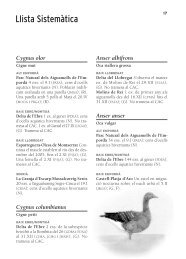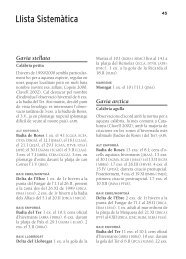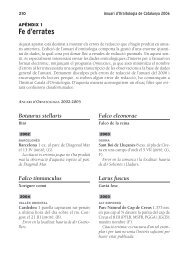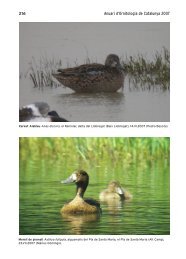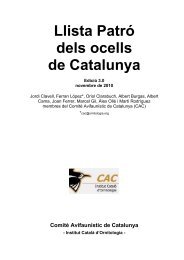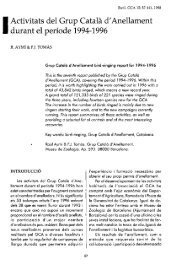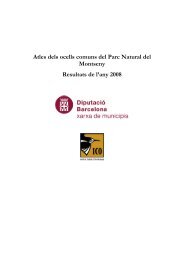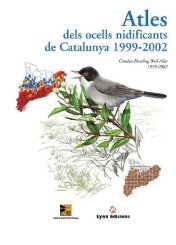Marking Great Tit Parus major nestlings - Institut Català d'Ornitologia
Marking Great Tit Parus major nestlings - Institut Català d'Ornitologia
Marking Great Tit Parus major nestlings - Institut Català d'Ornitologia
You also want an ePaper? Increase the reach of your titles
YUMPU automatically turns print PDFs into web optimized ePapers that Google loves.
Assessing the marking effort in chicks<br />
whereby chicks were ringed with elastic rings.<br />
Velcro leg-tags have also been used for gull<br />
chicks (Willsteed & Fetterolf 1986) and Brewer’s<br />
Blackbirds Euphagus cyanocephalus (Balph 1975).<br />
Fluorescent powder applied to feathers has also<br />
been used in precocial birds (Steketee & Robinson<br />
1995), although this procedure is presumably<br />
not suitable for altricial species.<br />
Some of these methods, however, may be<br />
difficult to apply in very small passerine species<br />
due to the small size of recently hatched chicks.<br />
In these species, one of the most widely applied<br />
techniques is the use of dyes and paints on<br />
different parts of the body including the claws<br />
(Oniki 1981), head (Roulin et al. 1999, 2000,<br />
Buechler et al. 2002) and legs (Balph 1975,<br />
Redondo 2000).<br />
However, individualizing with paint requires<br />
the re-marking of each chick several times<br />
during their development since, otherwise, the<br />
original markings are lost. The loss of marks in<br />
altricial <strong>nestlings</strong> are presumably related to: 1)<br />
environmental conditions such as temperature,<br />
which can alter the properties of the paint; 2)<br />
nestling behaviour in the nest since friction<br />
between chicks could speed up paint loss; 3)<br />
the dermal renovation of the skin. Moreover,<br />
different body parts may lose or retain marks<br />
at different rates due to different amounts of<br />
in-nest chafing and friction. For instance, we<br />
would expect differences in the speed of mark<br />
loss between marks on naked skin (epithelium)<br />
and on nails or feathers (keratin). More exact<br />
knowledge of the most important parameters<br />
causing marks to disappear could save research<br />
time and money, make marking efforts more efficient<br />
and avoid causing <strong>nestlings</strong> unnecessary<br />
stress due to ‘over-visiting’.<br />
Despite the number of published studies on<br />
dyeing or painting techniques in birds, surprisingly<br />
little work has been done to evaluate its efficiency<br />
or the possible deleterious consequences<br />
of marking animals (Calvo & Furness 1992,<br />
Gaunt & Oring 1999, Murray & Fuller 2000).<br />
The aims of this study were (i) to evaluate<br />
which factors determine the disappearance of<br />
the paint applied to the chicks of the <strong>Great</strong> <strong>Tit</strong>,<br />
a small altricial passerine species, (ii) to provide<br />
a predictive tool that will be useful in the design<br />
of marking experiments and (iii) to assess the<br />
possible negative consequences of the use of<br />
such a technique on <strong>nestlings</strong>.<br />
Revista Catalana d’Ornitologia 28 (2012)<br />
Material and methods<br />
The study was carried out during the 2003<br />
breeding season on a population of <strong>Great</strong> <strong>Tit</strong>s<br />
at the field station at Can Catà (Barcelona, NE<br />
Spain) in a forest dominated by oaks and pines<br />
[for more details see Senar et al. (1997)]. The<br />
<strong>Great</strong> <strong>Tit</strong> is an altricial species weighing 17 g<br />
that breeds in cavities but also readily nests in<br />
nest-boxes (Gosler 1993, Cramp 1998). In our<br />
study population females lay 3–11 eggs (authors’<br />
unpublished data).<br />
<strong>Marking</strong> experiment<br />
A total of 171 nest-boxes distributed throughout<br />
the study area were visited every four days in<br />
order to obtain data on the reproductive status<br />
of birds (nest building and laying and hatching<br />
dates). On day 1–3 post-hatching (taken as day<br />
1), half of the chicks of 48 pairs were randomly<br />
marked as soon as possible with red paint (Ecomarker<br />
® , Germany). When there was an odd<br />
number of chicks we always marked the additional<br />
unpaired chick. Eco-marker ® paint is used<br />
in the construction industry; it is particularly<br />
durable in harsh weather conditions, dries very<br />
quickly and is sticky, three reasons that make it<br />
a good candidate for marking birds. Nestlings<br />
(N nests = 48) were marked from day 1–3 on the<br />
toenails of a single foot, on one tarsus and on one<br />
wing (above the carpus). Unlike the head, these<br />
body parts are not (or only very poorly) visible<br />
to parents and so the chance of parents reacting<br />
abnormally to marked chicks was lessened.<br />
We evaluated the permanence of the paint<br />
on the chicks each time nests were revisited<br />
(2–7 days) by establishing an index of mark permanence,<br />
expressed in the form of a qualitative<br />
code: 0= No evidence of mark; 1= Few spots<br />
(remainders) of red paint still visible; 2= Mark<br />
obviously smaller but still clearly visible; 3=<br />
Mark practically intact. Although this index is<br />
qualitative, it does express a continuum of variation<br />
of increasing paint permanence. For this<br />
reason, we considered that we could calculate its<br />
mean value and perform regressions (see below)<br />
as if it were a quantitative variable.<br />
We considered the mean index value of each<br />
brood to avoid any possible pseudoreplication<br />
effect. The same observer (JQ) obtained all<br />
the data. In order to avoid a possible effect of<br />
21




